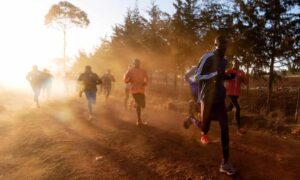
The drive from the tiny Eldoret airport to the town of Iten in the south-west corner of Kenya takes about an hour. It’s a winding unlit road with few road signs: you need to know where you’re going to get there. The town’s population isn’t known – there hasn’t been a census in more than a decade – but the local municipal authority estimates it around 56,000, up from 40,024 in 2009.
Roughly 35% live below the poverty line. And yet, a sign on the only paved road into town calls this the Home of Champions, owing to its phenomenal athletic success. This corner of Kenya has produced 14 men’s and nine women’s Boston Marathon winners since 1991, who have brought home 22 and 14 wins, respectively. They have also won 13 of 18 gold medals in the 3,000m steeplechase at the World Athletics Championships since the event was introduced in 1983.
Nearby, in Kaptagat, a rural town less than one hour’s drive from Iten, some of the fastest distance runners in the world live and train. These towns are similar. Life here is simple; there are few distractions, running is revered, long clay roads provide perfect running surfaces, and at 2,400 meters above sea level, they offer ideal high-altitude training conditions. But these conditions may not last.
Throughout east Africa, the most obvious climate hazards are drought, extreme heat, floods in some parts, and associated biodiversity loss. According to professor Vincent Onywera, the vice-chancellor for research, innovation and outreach at Kenyatta University, who has studied Kenyan runners most of his professional career, the climate crisis could seriously affect injury trends and performance. “I expect injuries to go up as droughts make clay roads harder than pavement and the impact on knees and hips takes its toll.”
The president of Athletics Kenya, Jackson Tuwei, is worried about more than just injury risks. He’s worried about participation overall. “If young athletes are hungry, they won’t run. If the air quality is bad because it is dusty and smoky, they won’t run. If there is no shade because trees have been cut down and there’s no water to drink or shower with they won’t run.” Drought will cut off the pipeline of athletes in Kenya unless solutions are found soon.
Heat is making things worse. Tuwei named this as his first concern for Kenyan athletes. “When we are running in the daytime it can be extremely hot and so sometimes we have to change our programmes to run in the evenings or very early in the morning. We have witnessed high temperatures here in recent years, forcing us to change our schedules for events.”
Sleep is another casualty of heat. Onywera stressed that a healthy sleeping schedule is critical to runners’ success, but that warmer nights across the country are shifting performance outcomes for some. “You can see the impacts of heat at night-time. Concentration dips, motivation is low, energy levels are low.”
Athletics Kenya is worried about how the climate crisis shapes the future of its country, let alone its sport. And yet there is little a country like Kenya can do to improve its climate outcomes as it contributes 0.05% of global emissions. Even if significant reductions in emissions are achieved, it will barely move the needle. So Athletics Kenya is choosing a different tack: educating its top athletes – some of the nation’s most visible people – to be spokespeople for the climate emergency.
